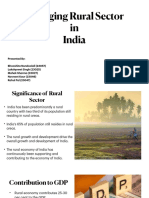0% found this document useful (0 votes)
50 views10 pagesRural Development Expanded Project
The document outlines the importance of rural development in India, emphasizing its role in improving the quality of life and economic conditions for the rural population. It discusses key areas such as agriculture, infrastructure, education, and health, along with government schemes aimed at enhancing rural livelihoods. Challenges and suggestions for future improvements are also highlighted, underscoring the need for strategic investment and collaboration to achieve sustainable growth.
Uploaded by
yuvrajkc002Copyright
© © All Rights Reserved
We take content rights seriously. If you suspect this is your content, claim it here.
Available Formats
Download as DOCX, PDF, TXT or read online on Scribd
0% found this document useful (0 votes)
50 views10 pagesRural Development Expanded Project
The document outlines the importance of rural development in India, emphasizing its role in improving the quality of life and economic conditions for the rural population. It discusses key areas such as agriculture, infrastructure, education, and health, along with government schemes aimed at enhancing rural livelihoods. Challenges and suggestions for future improvements are also highlighted, underscoring the need for strategic investment and collaboration to achieve sustainable growth.
Uploaded by
yuvrajkc002Copyright
© © All Rights Reserved
We take content rights seriously. If you suspect this is your content, claim it here.
Available Formats
Download as DOCX, PDF, TXT or read online on Scribd
/ 10






















































































